Anaphylactic shock is a rapidly or instantly developing systemic reaction in the body that threatens his life for due to a sharp violation of hemodynamics, namely, a drop in the level of blood pressure by at least 30% of the initial numbers. This decrease in blood flow leads to hypoxia of many vital organs and can damage them.
This anaphylactic the reaction is caused by the ingress of a specific irritant into the body in an amount that is not dangerous for healthy people. Often, the irritant enters the body again, and the pathways of entry do not play a role.
Record content:
- 1 Views
- 2 Stages and degrees
- 3 Symptoms
- 4 Reasons for the appearance
-
5 Diagnostics
- 5.1 International diagnostic criteria
- 6 When to see a doctor
- 7 Prophylaxis
-
8 Treatment methods
- 8.1 At the prehospital stage, it is necessary
- 8.2 Hospitalization
- 9 Possible complications
- 10 Video about anaphylactic shock
Views
According to ICD-10, there are the following types of anaphylactic shock:
- T 78.0 - Anaphylactic shock caused by a pathological reaction to food. Such a diagnosis is made with an established causative factor - a food allergen.
- T 78.2 - Anaphylactic shock, unspecified. In cases of unexplained etiology of shock and the absence of a proven allergen, this code applies.
- T 80.5 - Anaphylactic shock caused by the administration of serum. It is used in case of a confirmed reaction to the injected vaccine, serum, blood component.
- T 88.6 - Anaphylactic shock caused by a pathological reaction to a drug. Many classes of drugs are sensitizing and can provoke allergic or anaphylactic reactions.
Depending on the dominant symptomatology, there are such types of anaphylactic shock:
- typical - a combination of skin manifestations, respiratory and circulatory disorders,
- hemodynamic - the leading role in the pathogenesis is played by hemodynamic disorders,
- asphyxial - the main symptoms are broncho- and laryngospasm, laryngeal edema, suffocation,
- cerebral - first of all, signs of damage to the central nervous system appear and worsen,
-
abdominal - the organs of the abdominal cavity and their functions are most affected.
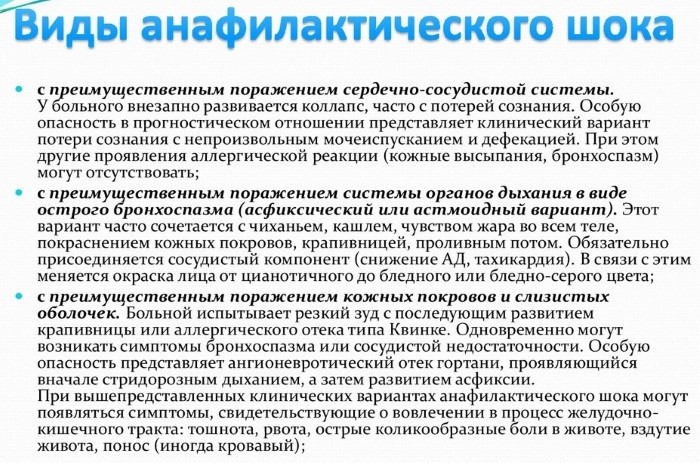
The following types of shock are also distinguished:
- Malignant course. It is characterized by a sudden onset and rapid development of dangerous symptoms - blood pressure drops critically (diastolic immediately to 0), respiratory failure develops sharply due to spasm of the larynx and bronchi, pulmonary edema, consciousness is lost. Even to the immediately provided therapy, there may be no reaction, multiple organ disorders are aggravated, and a coma occurs. This type of flow is the most dangerous and most often causes death.
- Acute benign course. Moderate hemodynamic disturbance is characteristic, consciousness is confused or darkened, respiratory failure of moderate severity. Symptoms are amenable to medical treatment and do not progress once it starts. The prognosis of this form is often favorable.
- Protracted nature course happens when therapy is started quickly. There is a partial improvement for the duration of the effect of long-acting drugs, but subsequently the symptoms are corrected more difficult. Here complications such as allergic encephalitis, hepatitis, nephritis, pneumonia often occur.
- Recurrent course. It has a wavy shape - after the first symptoms appear, it is quite easily corrected with drugs, especially long-acting. But after removing them from the body, a relapse of shock symptoms occurs, and sometimes it is very different and exceeds the original picture in strength due to the involvement of other organs and systems.
- Abortive course. It is manifested by minor circulatory disorders and signs of impaired respiratory function. It is quite easy to stop with medication, the most favorable form.
Stages and degrees
Anaphylactic shock is primarily a deterioration and insufficiency of blood flow.
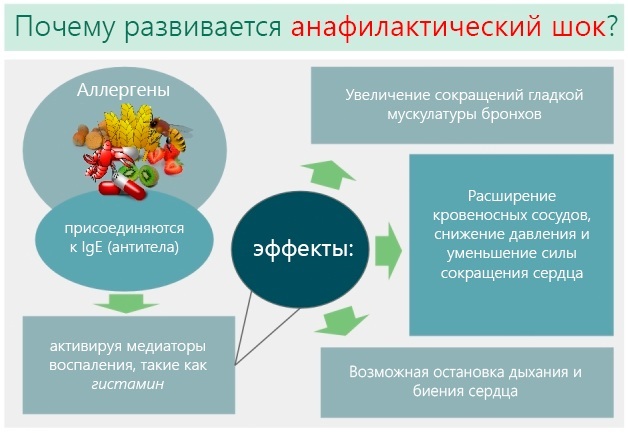
Depending on the severity, it can be of 4 degrees:
- 1st degree - initial. With her, circulatory disorders are insignificant, blood pressure is reduced by 30 mm Hg. from the original figures. It starts with mild manifestations - sore throat, rhinitis, cough, watery eyes, itchy skin, redness or swelling of the skin. The patient can be both frightened, anxious, and lethargic, apathetic. Consciousness is clear, headache or chest pain, shortness of breath may disturb.
-
2 degree - aggravation of hemodynamic disorders. The numbers of systolic blood pressure are in the range of 60-90, diastolic about 40 mm Hg, already at this stage collapse and loss of consciousness can occur. Patients experience weakness, fright, agitation, it becomes difficult to breathe and speak (up to complete aphonia) due to edema of the larynx and nasopharynx. There is pain in the chest, abdomen, ears, head, lower back, tinnitus. The skin turns pale or blue, shortness of breath and wheezing appear, the pulse quickens, arrhythmia may appear. Sometimes urination or bowel movements can occur involuntarily.

- Grade 3 - almost arrest of blood circulation, systolic blood pressure reaches 60-40 mm Hg, and diastolic blood pressure can approach 0. Patients lose consciousness, seizures may begin, pupils dilate, cyanosis of the skin and sweat spreads throughout the body, limbs become cold. On the peripheral arteries, the pulse may not be felt (or be threadlike), there are life-threatening types of arrhythmias.
- 4 terminal degree. It does not detect breathing and does not feel the pulse, blood pressure is 0.
Symptoms
Anaphylactic shock is a very fast reaction of the body, its development can occur in seconds or minutes after contact with a provoking factor and much less often takes hours. Symptoms of anaphylactic shock can be from a wide variety of organs and systems.
The skin may turn red, become edematous, hives, itching, burning are added. With the progression of anaphylaxis and a decrease in blood flow, the skin becomes pale or cyanotic (cyanotic), covered with sweat, the limbs become cold.
On the part of the respiratory system, sore throat, runny nose, sneezing, coughing, hoarseness appear. They are replaced by shortness of breath, difficulty speaking, swallowing and breathing, wheezing, whistling due to laryngeal edema. In later stages, pulmonary edema may join.
The cardiovascular system reacts as sharply as possible - blood flow in many tissues and organs deteriorates sharply due to a strong decrease in blood pressure and collapse. As a result, tachycardia appears, pressing chest pain, and the pulse becomes weak, threadlike.
The central nervous system is immediately involved in pathogenesis. Patients are either restless, frightened, or may be indifferent and inhibited. Then there may be a headache, "flies" before the eyes, dizziness.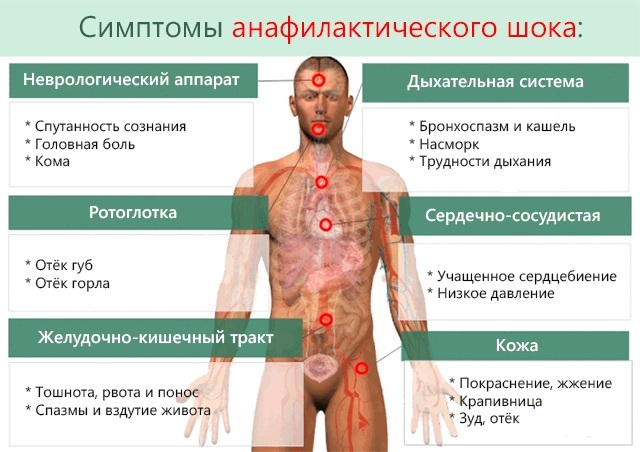
After the onset of hypoxia, the brain becomes confused, dimmed or lost consciousness, involuntary urination and defecation may occur. Pupils become dilated, patients fall into a coma. On the part of the digestive system, nausea, vomiting, diarrhea, as well as pain in different parts of the abdomen are possible.
The combination of characteristic lesions of two or more organ systems correspond to the clinical picture of any form of anaphylactic shock, but with a mandatory hemodynamic disorder.
Reasons for the appearance
Anaphylactic shock can be caused by two main groups of causes, these are allergic and non-allergic. Allergic factors should, upon initial contact, cause sensitization of the body (asymptomatic), and already repeated interaction can lead to the development of anaphylaxis.
It can be:
- Medications. Certain classes of common drugs often cause allergic reactions. These include a number of antibacterial agents (penicillins, cephalosporins, carbapenems), opiate drugs (hypnotics, sedatives, anesthetics), barbiturates (hypnotics), cytostatics, radiopaque substances, muscle relaxants.
- Food products. They can be cow's milk, chicken eggs (their protein), meat, nuts (especially peanuts), fish and seafood (shrimp, caviar, liver, mussels), all types of citrus fruits, strawberries, chocolate, spices. Foods are mainly the cause of anaphylaxis in children.
- Poisonous substances and poisons of animal origin (hymenoptera insects, snakes, scorpions, spiders, jellyfish).
- Injected drugscontaining components of human or animal organisms (blood and its components, serums, hormones, enzymes, diagnostic preparations with allergens).
- Some substances, plant or animal origin - dust, fluff, pollen, wool, plant sap.
- Synthetic substances of various structures, latex, dyes, flavors.
Non-allergic factors - provocateurs of anaphylaxis can cause shock already at the first contact with them.
This is:
- often used in medicine - hypertonic solutions (mannitol), colloidal solutions (hydroxyethyl starch, dextran),
- non-steroidal anti-inflammatory drugs (NSAIDs, especially aspirin, analgin, diclofenac),
- exercise stress,
- taking with food substances similar to mediators that provoke allergies (histamine, tyramine) with a lack of enzymes that break down them.
Diagnostics
Anaphylactic shock is a condition that can develop and lead to dangerous consequences and death in a very short time. Therefore, in the diagnosis, the main role is played by the questioning of the patient for anamnesis and complaints, examination and a quick physical examination. The combination of the clinical picture and the events preceding the shock make it possible to clarify the diagnosis.
When interviewing a patient, be sure to find out the following:
- What preceded the onset of symptoms - medication, insect bite, food. Find out in as much detail as possible with what the patient contacted to establish the causative factor.
- How much time has passed since the first manifestation of signs of anaphylaxis, how quickly the symptoms appeared and developed.
- Risk factors. Diseases such as bronchial asthma, atopic dermatitis, rhinitis, mastocytosis, cardiovascular disease, and also old age and the use of certain antihypertensive drugs, significantly increase the risk of developing anaphylactic shock.
Complaints characteristic of anaphylaxis are weakness, fear, dizziness, pain in the head, heart, abdomen, difficulty breathing, pruritus, palpitations, dizziness, nausea.
During the examination, you can find hyperemia or pallor of the skin, rhinitis, edematous mucous membranes of the nasopharynx and palate, tachycardia, arrhythmia, low blood pressure of at least 30% of the original figures, wheezing in the lungs, convulsions, collapse.
International diagnostic criteria
| Mandatory criterion manifested shortly * after exposure to the alleged causative factor | Additional criteria (at least 1 of them), manifested shortly * after contact with the alleged causative factor and combination with skin manifestations - irritation, urticaria, flushing | Additional criteria (at least 2 of them), manifested shortly * contact with after the alleged causative factor |
| drop in systolic blood pressure in adults below 90 mm Hg or more than 30% of the baseline, in children also more than 30% of the baseline | respiratory failure - laryngeal edema, bronchospasm, hypoxemia, shortness of breath | Skin and mucous manifestations - swelling of the mucous membranes of the nose and throat, tonsils, itching, rash all over the body, angioedema |
| respiratory failure - laryngeal edema, bronchospasm, hypoxemia, shortness of breath | ||
| decrease in blood pressure, manifestations of hypoxia of various organs and systems - collapse, confusion, sudden defecation or urination, dilated pupils | decrease in blood pressure, manifestations of hypoxia of various organs and systems - fainting, confusion, sudden bowel movements or urination, dilated pupils | |
| disorder of the gastrointestinal tract - nausea, vomiting, abdominal pain |
* soon - after a few minutes, less often - hours.
When to see a doctor
If you find at least one suspicious symptom, and even more so several, you need to urgently seek medical help.
This is especially true for patients who are at risk - age-related, with a history of allergic or anaphylactic reactions, as well as those suffering from bronchial asthma or other atopic diseases. Before the hospital, a paramedic will be able to provide assistance with an anti-shock first-aid kit and instructions for administering the drug.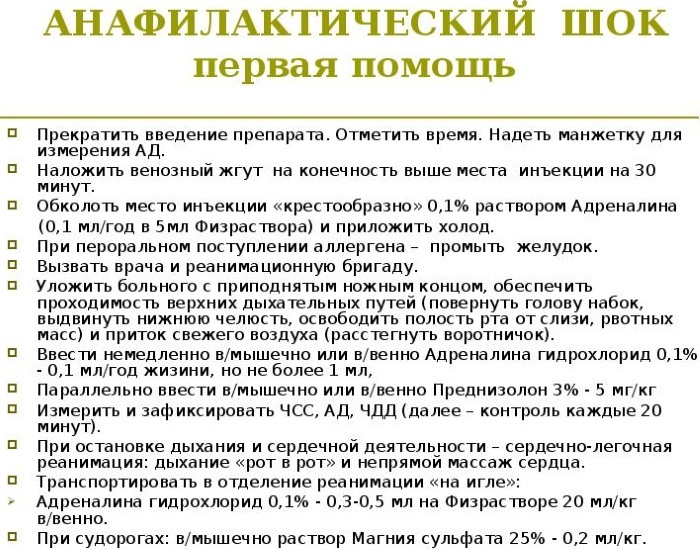
Ideally, this should be a doctor who is especially able to carry out emergency resuscitation measures and has the necessary honey in the arsenal. drugs. It can be an ambulance doctor, therapist, anesthesiologist-resuscitator, surgeon.
Often, the patient's life depends on the speed and correctness of medical measures in shock. In acute, rapidly progressing forms of anaphylactic shock, a high mortality rate is precisely due to the lack of adequate assistance immediately when the first symptoms appear.
Prophylaxis
Anaphylactic shock is when primary prevention includes only measures precautions, and secondary prevention is more effective, which allows you to avoid the action of already known factors.
Primary prevention includes:
- Before hospitalization, surgery, prescription or administration of any medication, it is imperative to collect an allergic history. If hypersensitivity to the drug is suspected, skin allergy tests should be performed. Most allergenic drug classes should be avoided whenever possible. If they need to be introduced, then the patient should be observed for at least 1 hour for the appearance of specific symptoms.
- To prevent a reaction to food, especially in children, a minimum amount should be given for the first time on the sample and possible reactions should be evaluated up to 2 days. Be careful when trying protein foods of animal origin, eggs, nuts, some fruits and berries.
- When injecting toxoids and serums, it is better to use human ones. If this is not possible, then antihistamines and glucocorticosteroids should be taken before the introduction of animal serum.
- When conducting provocative allergy tests, it is advisable to do this in a hospital setting, not to inject endotracheally, to confirm the presence of a reaction to the allergen by detecting IgE in the patient's blood.
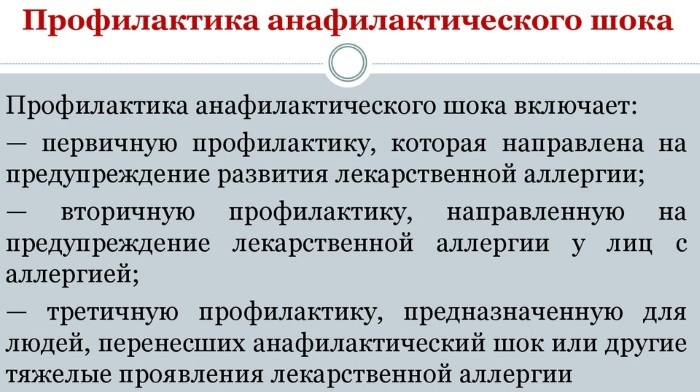
Secondary prevention:
- The main thing is to avoid contact with factors that previously caused the reaction of anaphylaxis.
- Conducting after the first case of anaphylaxis, specific immunoprophylaxis measures that reduce the sensitization of the body.
- Always carry the information sheet on the factors causing anaphylaxis in a conspicuous place.
- With regular anaphylaxis or the risk of meeting with a provocative factor, take antihistamines.
- At high risks, always have a syringe pen with adrenaline or an autoinjector with you.
Treatment methods
If anaphylactic shock is suspected, first aid measures should be provided immediately, and the patient should be taken to a medical facility as soon as possible.  In this case, one should strictly follow the generally accepted plan for combating anaphylactic shock and carry out treatment according to the protocol.
In this case, one should strictly follow the generally accepted plan for combating anaphylactic shock and carry out treatment according to the protocol.
At the prehospital stage, it is necessary
- Find out the reason, factor, after contact with which the first signs of hypersensitivity appeared.
- Call an ambulance, better resuscitation.
- Stop or limit as much as possible the contact or intake of this substance. For example, remove an insect sting from a wound, apply a tourniquet above the bite site, apply ice to the injection area, remove ingested foods from the body, causing vomiting.
- While waiting for a doctor or transportation, the patient should be given a horizontal position with a raised leg in order to prevent hypotension or collapse. The head should be turned on its side in case of an attack of vomiting and aspiration of masses into the lungs. You also need to push the lower jaw forward, remove the dentures (if any).
- With a sharp asphyxia, bronchospasm, urgently carry out tracheal intubation. If there is no endotracheal tube, a conicotomy is performed (any available thin hollow object, such as a pen, is inserted into the space between the cricoid and thyroid cartilage). In this position, the patient will be able to breathe through the tube until resuscitation.
- Inject 0.3-0.5 ml of 0.1% adrenaline solution into the anterolateral surface of the thigh. If there are no changes in blood pressure or pulse, or if they worsen, repeat the same administration of epinephrine.
- During transportation, in the presence of spontaneous breathing, provide access to oxygen or fresh air to the patient, including through a mask. In case of respiratory failure, spasm or laryngeal edema, collapse, coma, absence of blood pressure, bleeding, mechanical ventilation is performed.
- Establish access to the large peripheral veins using two wide catheters. After that, I start the transfusion of nat. sodium chloride solution in an amount equivalent to a decrease in blood pressure. At the initial stage, it can be 1-2 liters of physical. solution, then up to 4-6 liters, including colloidal solutions.
- Constantly monitor pulse rate, blood pressure, ECG, gas metering and respiration.
- With a further deterioration in the patient's condition, it is necessary to carry out resuscitation measures - an indirect heart massage, performing 100-120 pressures per minute. It must be done before admission to the doctor.
Hospitalization
- The introduction of adrenaline 1 ml 0.1% intravenous stream or drip, under the control of blood pressure and pulse.
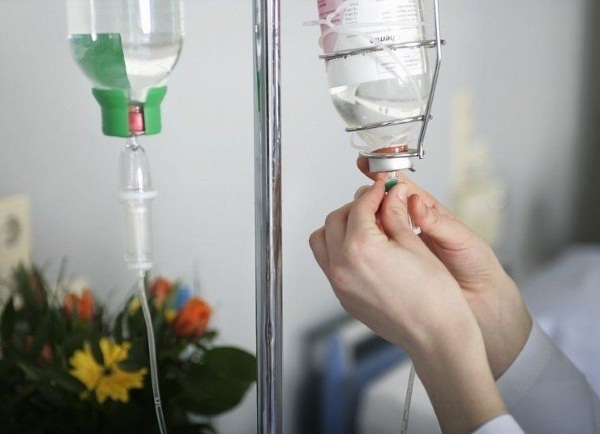
- With an insufficient effect of adrenaline or side effects, they switch to the introduction of norepinephrine or dopamine, which have the same pressor effect on the vessels. The number and duration of their administration is determined by hemodynamic parameters.
- The circulating blood volume is replenished by infusion of sodium chloride and dextran in the required quantities.
- Blockers of H1-histamine receptors are indicated for bright cutaneous and obstructive manifestations, they do not affect hemodynamics.
- Systemic glucocorticosteroids (dexamethasone, prednisolone, methylprednisolone) are administered to prevent late complications of anaphylactic shock.
- With prolonged bronchospasm, a nebulizer with Salbutamol is used.
After elimination of the symptoms of anaphylactic shock and stabilization of the condition, patients remain in the hospital for a maximum of 24 hours under medical supervision.
In case of an unknown provoking factor, high risks or concomitant bronchial asthma, it is recommended after discharge carry epinephrine pens, antihistamines and corticosteroids to help yourself with relapse.
If the source of anaphylaxis is identified, specific immunotherapy is subsequently carried out.
Treatment of shock patients with folk methods is unacceptable. Since for the time spent (even a few minutes), serious complications, deterioration and death of the patient can be missed.
Possible complications
If the necessary assistance is not provided in a timely manner to a patient in a state of shock, with a probability of at least 90%, a lethal outcome will occur.
The consequences of prolonged hypoxia and lack of blood circulation can damage internal organs of an ischemic nature - strokes, heart attacks, pathologies of the lungs, kidneys, liver, abdominal organs cavity.
Anaphylactic shock is a very serious complication of anaphylaxis and allergies, as well as an individual reaction of the body to some newly encountered factors. It is most important to timely diagnose and provide medical assistance to the victim, since this condition progresses very quickly and can lead to rapid death.
Author: Natalia Kalegova
Video about anaphylactic shock
Doctor about anaphylactic shock:



